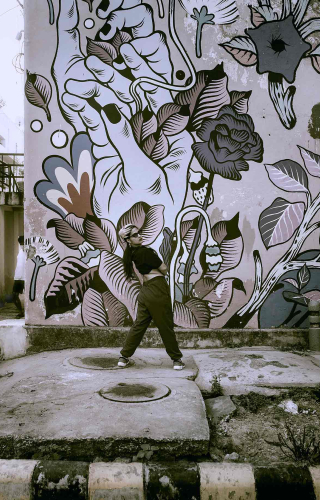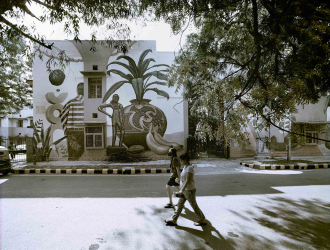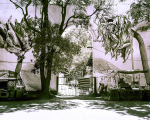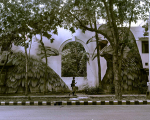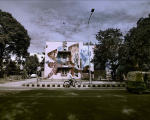One fine day, while I was driving through the leafy lanes of Lodhi Colony, I stumbled upon a huge dahlia painted on the wall of one of the houses. I stopped my car to take a good look. Oh wait, there was another one on the next wall, with a gigantic grasshopper peeking out from behind its stem. I was struck by the large scale of these murals and wondered why are they were painted in a residential neighbourhood. Though not my first visit there, but I couldn’t remember seeing street art in Lodhi Colony or anywhere else in the Lutyen’s Bungalow Zone!
My curiosity was noticed by a fruit vendor sitting underneath the dahlia mural. ‘Pehli dafaa aayen hain madam jee (Are you here for the first time, Madam)?’ asked the fruitwala. ‘Na, na,’ I was embarrassed, not wanting to sound uncool at my lack of familiarity. ‘Ye to bane hue teen-char saal ho gaye. Mere hi saamne to bana hai! Aage aur bhi milenge aapko, poora calony mein bana hua hai jee! (It has been 3–4 years since these were made. They were painted in front of me. You will find a lot of these all over Lodhi Colony)’ claimed the guy. I nodded my head, thanking him for the information, and thought of exploring the area to find more such artwork.
Lo and behold! As promised by the fruitwala, sure enough there was another drawing in the next lane. A set of large eyes and a pair of huge beaks peeked out from behind the trees! I was looking at two beautifully painted pigeons facing each other, as if they were having a conversation. Each feather had been painstakingly painted, and the pigeons looked alive. The artist must have extraordinary knowledge of birds to have laboured over them so lovingly, I thought.
I was curious about who these artists were and what was the purpose of these beautiful murals! Of course, the scale of the walls provided a perfect canvas for such art, but who were the intended audience? These drawings fascinated me, after all at one point of time I was obsessed with hoarding art and film posters during my advertising days! Soon enough I came to know that these murals were made as part of the Lodhi Art Festival, the brainchild of St+Art India Foundation, a not-for-profit organisation that works on art projects in public spaces with the intent of making art accessible for all.
Formed on the principle of ‘Art for All’, St+Art India Foundation was established in 2014 by five curators—Arjun Bahl and Thanish Thomas, who have a background in events and logistics, filmmaker Akshat Nauriyal, urban art curator Giulia Ambrogi and Hanif Kureshi, an artist who has been actively involved in the street art community. The first public artworks were made in the Shahpur Jat neighbourhood. The idea was to make public spaces more vibrant and interactive for the people who use them daily, and to bring art out of high-end galleries—a privilege of a select few—directly to the public.
Though the seed idea was formed, making art democratic is easier said than done. Street art has a notorious reputation for vandalism and being anti-establishment. St+Art India Foundation had to take into confidence municipal authorities, get permissions from residents and find sponsors. While some residents didn’t allow their walls to be painted, some agreed. In 2015, recognising the potential in building a brand image of New Delhi, the Central Public Works Department (CPWD) partnered St+Art India Foundation to convert the Lodhi Colony area into the first open-air art district in India. Support also came from Asian Paints, who supplied the paint, and Swachh Bharat Mission. St+Art India Foundation also reached out to cultural institutions, consulates and embassies to bring international artists and fund projects.
International artists allowed the artwork to be an eclectic mix, reflecting styles from various countries. The themes selected were not just reflective of a globalised world but artists also incorporated details like arched doorways, window frames, typography and locally growing vegetation into their murals, making their art an integral part of the local milieu. The exterior wall facades were large and symmetric, which meant that almost every artist got a similar canvas to play with. Artists who come from aboard expressed their impression of India and snippets of Delhi’s street life and culture. Some themes are abstract but most address contemporary social, cultural and environmental issues like climate change, equal rights for marginalised communities and impact of technology on modern life.
By unshackling art from curated spaces, St+Art India Foundation has successfully translated their vision of ‘Art for All’ into reality. Their quest for finding new canvas continues. They have made murals at transportation hubs, busy markets, water tanks and school classrooms. For the artist, any large surface is a potential canvas, even garbage dumpsters! The murals demonstrate how modern spaces can be part of a city’s heritage and have potential to become icons of new culture. Public spaces, which are largely transitory in nature, need not be sterile, instead they can initiate a conversation. St+Art India Foundation looks at public spaces as an interactive zone, which can make people stop, think and engage!
Giant colourful murals have infused new life and purpose to the Lutyen’s bungalows in Lodhi Colony which were designed to be purely functional. It has put Lodhi Colony on the tourist map and given a sense of community pride amongst its residents. In a way, the visual repackaging of Lodhi Colony is not very different from what Sir Edwin Lutyens incorporated in New Delhi, which had plenty of elements of Mughal architecture and other Indian building forms, like the Buddhist Stupa and jaali work. In this way, Lutyens gave a sense of visual continuity, merging old motifs with new forms, thus creating something new and distinctive, a style which still bears his name. This is the same objective of St+Art India Foundation, and their efforts mark a significant moment in the evolution of street art in India.
This photo-essay has been created as part of the Sahapedia Frames Photography Grant, supported by CSR funding from IndusInd Bank.
